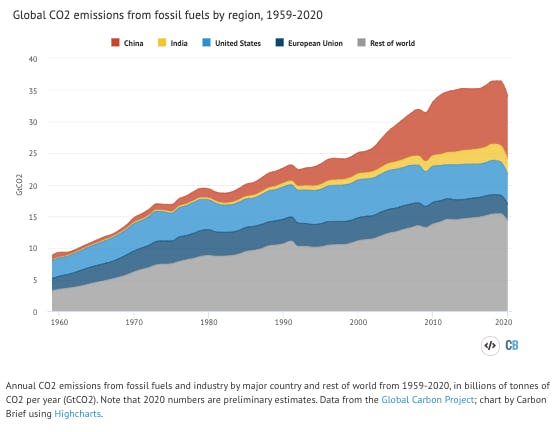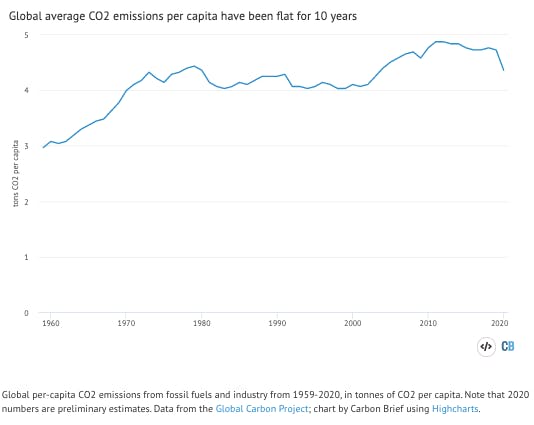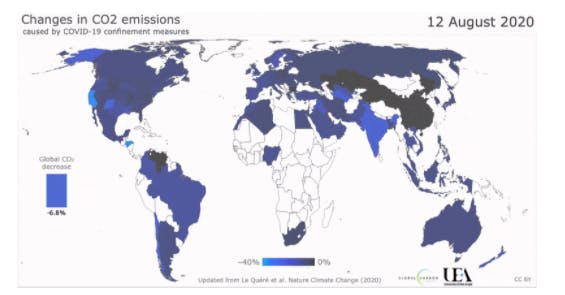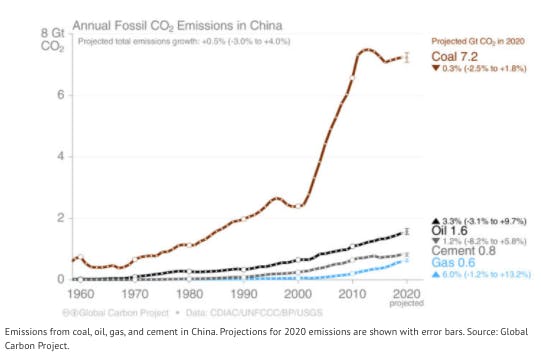Global carbon dioxide (CO2) emissions from fossil fuel and industry are expected to drop by 7 per cent in 2020, new analysis shows, as economies around the world feel the effects of Covid-19 lockdowns.
The latest estimates from the Global Carbon Project (GCP) suggest that these emissions will clock in at 34bn tonnes of CO2 (GtCO2) this year – a fall of 2.4GtCO2 compared to 2019.
This annual decline is the largest absolute drop in emissions ever recorded, the researchers say, and the largest relative fall since the second world war.
Fossil CO2 emissions have fallen in all the world’s biggest emitters, the study estimates – including by 12 per cent in the US, 11 per cent in the EU, 9 per cent in India and 1.7 per cent in China.
Combined with the impacts of land-use change, human-caused CO2 emissions this year will total 40GtCO2, the estimates suggest. This will see atmospheric CO2 levels increase to an annual average of 412 parts per million – 48 per cent higher than before the Industrial Revolution.
While a drop in emissions in a single year will not slow the pace of global warming, the researchers say, there is a “unique opportunity” to secure long-term emissions cuts by following an economic recovery “aligned with tackling climate change”.
What is the impact of Covid on 2020’s CO2 emissions?
The provisional estimate of CO2 emissions in 2020 is the GCP’s 15th in an annual series of “global carbon budgets” produced by an international group of scientists. This year’s study, published in Earth System Science Data, uses four different methods to assess regional and global emissions across the world.
The findings highlight the scale of the impact that Covid-19 has had on the world’s economies.
The peak of the decrease in emissions this year occurred in the first half of April, the researchers say in a briefing document. This was when lockdown measures in response to Covid-19 were at their most comprehensive – particularly in Europe and the US, they note:
“At that point, daily global fossil CO2 emissions were around 17 per cent below their average 2019 levels.”
For the year as a whole, the researchers estimate that CO2 from fossil fuels and industry (FF&I) – which includes emissions from burning fossil fuels, manufacturing cement and other industrial processes – will decline by 2.4GtCO2 compared to 2019. This has “never been seen before”, the researchers say, and is equivalent to a drop of 7 per cent in global emissions.
Dr Glen Peters, research director at the Centre for International Climate Research (CICERO) in Norway, told a press briefing:
“You’d have to go back to 1945 – the second world war – to see a relative drop bigger than this 7 per cent.”
This year has also seen the first clear fall in global emissions since a 1.3 per cent drop in 2009 – visible in the chart below – which was driven by the global financial crisis that started in 2008.

That crisis was followed by a “huge rebound” in emissions in the early 2010s, explained Peters. Global emissions subsequently plateaued between 2014 and 2016, he said, which started to get scientists “a little bit excited that maybe emissions were peaking”. However, emissions then “jumped up again” in 2017 and 2018 before levelling out in 2019.
With emissions staying “about flat in 2019”, there was more talk of “whether a peak in emissions was coming”, Peters continued, including “some positive trends in certain countries, which were helping to get global emissions down”.
To see whether this was indeed a peak, rather than just a pause in rising emissions, “we needed another year or two”, Peters said. However, the impact of Covid-19 means “we’re not going to know if emissions were coming up to a peak”, he added, “at least not for a few more years now”.
Decadal trends and economic recovery
The new study notes that global CO2 emissions “have increased every decade” since the 1960s. And, while the growth rate in emissions declined from 4.3 per cent per year in the 1960s to 0.9 per cent per year in the 1990s, it has increased again in the 21st century – to 3.0 per cent per year in the 2000s and 1.2 per cent per year in the 2010s.
While emissions have continued to grow, per capita emissions have remained relatively flat over the past decade. The chart below shows global average per-capita emissions for each year from 1959 to 2020.

On the five-year anniversary of the Paris Agreement, which is marked this week, the researchers note that “the growth in global CO2 emissions has begun to falter”. However, the rebound in emissions seen in the aftermath of previous global crises suggests that the way countries stimulate their economies after Covid-19 lockdowns will play a key role in future emissions.
(Carbon Brief has been tracking the “green recovery” plans that have been proposed, agreed and implemented by major economies around the world.)
Prof Corinne Le Quéré, a Royal Society research professor of climate change science at the University of East Anglia, told journalists that “this year alone will not change anything” in terms of the pace of warming, but economic stimulus packages “will have a massive effect”.
The huge impact of Covid-19 lockdowns means a rebound in global emissions “is very likely”, Le Quéré added, but “what is more difficult to say is exactly what the size of the rebound will be in 2021 – whether it will come back to the 2019 level or perhaps even higher”.
Stimulus packages “will make a difference” to emissions in 2021, Le Quéré noted, but “there are a lot of investments that could be aligned with tackling climate change that will take longer to kick in”.
Le Quéré also referenced a recent study – covered by Carbon Brief – that found that a global economic recovery “tilted towards green stimulus and reductions in fossil fuel investments” offers a “good chance” of limiting warming to 1.5C.
Also referring to the Paris global warming limits, Prof Pierre Friedlingstein, chair in mathematical modelling of climate systems at the University of Exeter, told the press briefing that “we need sustained reductions in emissions of 1-2GtCO2 per year over the next 20-30 years to limit warming well below 2C”.
The combination of economic stimulus packages, the drop in emissions in 2020, new net-zero commitments and the emerging effects of existing climate policies provides a “unique opportunity” to make long-term cuts to global emissions, Friedlingstein added.
China slows emissions reduction
The study finds that 2020 will see emissions reductions of 9-12 per cent in the US, EU and India, as lockdowns accelerate a pre-existing trend of decreasing emissions.
However, in China, the expected reduction in emissions for 2020 is much more modest. This is partly due to its trend of increasing emissions in recent years, but also a result of an earlier, shorter lockdown that allowed emissions to rebound more quickly, the researchers say.
The animation below – an update from a study by Le Quéré and colleagues earlier this year – shows how daily CO2 emissions changed as individual countries locked down in response to Covid-19 throughout 2020. The most intense blue shading shows the largest changes.

The plot below shows the changes in fossil fuels emissions for the four highest emitters – the US, China, EU and India – for 2017 to 2020, as well as the rest of the world. It highlights that emissions fell in every country or region shown.
US
US emissions from fossil fuels contributed 14 per cent of the global total in 2019. However, researchers explain that overall emissions in the US have been decreasing by 0.7 per cent per year for the past decade, largely driven by a decrease of roughly in emissions from the burning of fossil fuels since 2010.
The researchers predict a 10 per cent reduction in emissions from the burning of fossil fuels in the US in 2020 and 12 per cent reduction in its overall emissions.
The study estimates that the Covid-19 pandemic will drive down US coal emissions by 18 per cent in 2020. Furthermore, despite the trends of increasing emissions from oil, gas, and cement over recent years, they are projected to decline this year by 14 per cent, 1.7 per cent and 0.5 per cent, respectively.
The researchers also note that the US has seen a significant decrease in coal emissions use in recent years, accompanied by a boom in shale gas and strong growth in renewable energy.
“Covid-19 essentially accelerated or locked in some of those declines in coal,” Peters told the press briefing.
EU and UK
The researchers estimate a drop in CO2 emissions in the EU27 of 11 per cent for 2020.
The EU has experienced similar changes in coal use as the US over the past decade, the researchers note. Emissions from oil, gas and cement are also estimated to drop by 12 per cent, 3 per cent and 5 per cent, respectively, this year – although consumption of both oil and gas have been rebounding in recent years, the study notes.
According to researchers, a 13 per cent drop in emissions is predicted in the UK this year as a result of the extensive lockdown measures introduced in March, plus the second wave of the pandemic. This is “one of the biggest drops worldwide”, Le Quéré told the press briefing, adding that “the only country that has a bigger drop is France with 15 per cent”.
India
The researchers note that CO2 emissions in India – the world’s third largest emitter – were already below their normal levels in 2019 before the pandemic hit. This was a result of “economic turmoil and strong hydropower generation”, the researchers say, adding that emissions in India only rose by 1 per cent in 2019.
This anomalously low growth in emissions was noted in a Carbon Brief analysis in October 2019.
“India is a little bit interesting,” Peters told the press briefing. “It’s had rapid growth in the last decade at around about 5 per cent per year. Things were looking a little bit shaky last year – a weaker economy, a big year for hydro because of weather, so emissions didn’t grow much in 2019.”
Despite a trend of growing emissions in India from oil and coal over the past decade – alongside moderate growth in gas and cement – the pandemic is expected to reduce emissions by 7 per cent, 10 per cent, 2 per cent and 15 per cent, respectively, in these four areas in 2020.
As a Carbon Brief analysis in May noted, 2020 is the first year in four decades in which emissions in India have dropped. According to the researchers, a 9 per cent reduction in emissions is expected in India over 2020.
China
As the largest emitter in the world, China has been “dominating the global trend” of CO2 emissions over the past decade with an increase in emissions of 1.2 per cent per year, the researchers say.
In fact, last year’s GCP update noted that global fossil fuel emissions in 2019 would have decreased were it not for China’s rising emissions.
While China has seen a modest rise in gas, oil and cement emissions over the past decade, the main driver of this rise in emissions is from coal use. The plot below – from the GCP – shows annual emissions from coal, oil, gas and cement in China since the late 1950s.

China’s emissions from coal are expected to decrease by 0.3 per cent over 2020, the researchers say, but will still total an estimated 7.2GtCO2. China is also expected to see an increase in both oil and gas emissions of 3 per cent and 6 per cent this year.
Furthermore, the researchers note that the pandemic started earlier in China and the lockdown period was shorter, so emissions rebounded much more quickly. The relative drop in emissions from China due to the pandemic is, therefore, smaller than the other big emitters, with a decrease of 1.7 per cent expected in 2020.
Carbon Brief analysis published in June found that although “emissions fell an estimated 25 per cent in the six weeks following the lockdown, from early February to mid-March“ in China, and decreased again in April, they had already rebounded past pre-covid levels by May.
Another Carbon Brief piece published this month reported that “China’s CO2 emissions have rebounded from a steep, but short-lived, fall due to the Covid-19 lockdown to reach a new record high”, largely due to a ramping up of steel production.
Rest of the world
For the rest of the world, emissions from coal, oil, gas and cement are expected to drop by 7 per cent, 7 per cent, 4 per cent and 0.5 per cent, respectively, in 2020, the study finds. This contributes to an estimated overall 7 per cent reduction in emissions for 2020.
Surface transport emissions halved
The impact of Covid-19 has hit every sector of society. The chart below – an update to data published in a study by Le Quéré and colleagues earlier this year – shows the reductions in daily CO2 emissions for a range of sectors through 2020. It discounts other factors, such as natural variability, the temperature-induced change in heating demand and the effect of economic stimulus packages that have already begun.
The chart highlights how surface transport – travel by roads and rail – has been the sector most affected by lockdowns around the world. This is also reflected in the next chart, which shows the global trend for changes in CO2 emissions from 2017 to 2020, split by fuel type.
The most significant reduction in emissions this year is from oil, which dropped by almost 1GtCO2 in 2020.
The GCP estimates that emissions from surface transport fell by approximately half at the peak of the pandemic and analysis in October found that ground transport emissions had been cut by 841MtCO2 compared to the same time period in 2019.
This is a significant factor for the global emissions reduction, as surface transport accounts for roughly 20 per cent of global emissions, the researchers say.
This decrease is largely due to reductions in road emissions. Le Quéré told the press briefing that these changes “were not a structural decrease, but forced changes in behaviour” and so the emissions were likely to pick up again rapidly following a relaxing of Covid-19 restrictions.
Emissions from aviation were also reduced drastically, with a reduction of 75 per cent seen during the peak of Covid-19 lockdowns. However, aviation emissions “account for just under 3 per cent of global emissions”, the researchers note, and so the change in emissions from this sector was much less significant for the overall decrease in emissions.
At the start of December 2020, emissions from road transport and aviation were still below their December 2019 levels, by approximately 10 per cent and 40 per cent, respectively, the researchers note. They add that the combined effects of reductions in aviation and surface transport emissions are acting to keep global monthly emissions in December 2020 roughly 3 per cent below their December 2019 levels.
Meanwhile, coal emissions also fell. “Emissions from coal use was sort of trending downwards, which is a good sign”, Peters told the press briefing. However, it is not possible to determine if this was a sustained trend due to the impacts of the pandemic, he added: “It will be interesting to see how coal rebounds in the next years ahead.”
The chart below highlights that coal still makes a large proportion of fossil CO2 emissions each year.
Emissions from industry – including the production of metals, chemicals and manufacturing – make up 22 per cent of global emissions. During the peak of Covid-19 lockdowns, emissions from this sector dropped by up to 30 per cent, the study finds, and restrictions are still acting to reduce emissions from industry in many worldwide.
The rebound in emissions from industry “could be pre-existing trends in industry”, Le Quéré told the press briefing, or it could be “the beginning of the effect of economic stimulus in countries such as China”.
And, finally, electricity generation is the most highly emitting sector in the world, contributing 44 per cent of global emissions. During the peak of the pandemic, emissions from this sector were cut by up to 15 per cent, the study finds, largely due to the previously mentioned reductions in coal in the EU and US.
Carbon sinks and sources
While CO2 emissions from extracting, transporting and burning fossil fuels make by far the largest contribution (an average of 81 per cent over 1959-2019) to global emissions, a substantial portion (19 per cent) come from land-use change.
While fossil emissions have continued to grow, CO2 emissions from land use, land-use change and forestry “have remained relatively constant” over the past half-century, the paper says.
Land-use emissions in 2020 are “similar to the previous decade’s average” at around 6GtCO2, the researchers say. This is lower than the “anomalously high emissions in 2019”, which saw the highest rates of deforestation in the Amazon since 2008 and huge fires across Indonesia’s carbon-rich peatlands.
Combining fossil and land-use emissions gives a total CO2 emissions of around 40GtCO2 in 2020, compared to 43GtCO2 in 2019, the researchers say.
These carbon “sources” are partially offset by carbon “sinks” that soak up a significant portion of human-caused emissions each year. The paper estimates that the ocean and land surface absorb an average of 24 per cent and 32 per cent of annual emissions, respectively.
This leaves around 45 per cent of emissions that end up in the atmosphere each year. Here, they add to the accumulation of CO2 that is warming the Earth. Taken together, these elements are known as the “global carbon budget”.
(This differs from the commonly used term “carbon budget”, referring to the amount of CO2 that can be released while keeping warming below global limits of 1.5 or 2C.)
This year’s budget is shown in the figure below. Values above zero represent sources of CO2 and values below zero represent carbon sinks.
With the addition of this year’s emissions, the study estimates that the level of CO2 in the atmosphere will increase by 2.5 parts per million (ppm).
This is “near the 2019 growth rate”, the researchers say, despite the lower emissions. They note that large year-to-year variations in the natural land sink can cause variations in how much CO2 makes to the atmosphere.
Analysis for Carbon Brief – published earlier this year – predicted that atmospheric CO2 would rise by 2.48ppm this year. The authors added:
“This increase is 0.32ppm smaller than if there had been no lockdown – equivalent to 11 per cent of the expected rise. This means that, although global emissions are smaller, they are still continuing – just at a slower rate. Additional CO2 is still accumulating in the atmosphere.”
This year’s emissions will “bring the 2020 atmospheric CO2 concentrations to an expected level of 412ppm averaged over the year”, the paper says. This means that atmospheric CO2 levels in 2020 will be 48 per cent above pre-industrial levels, 16 per cent above 1990 and 3 per cent above 2015, the researchers note.
This story was published with permission from Carbon Brief.














